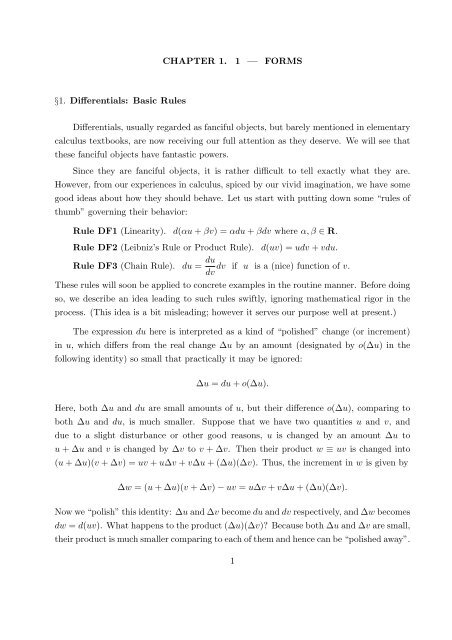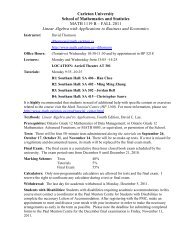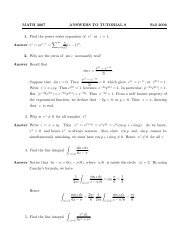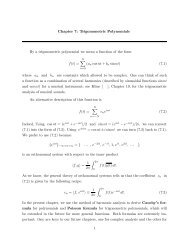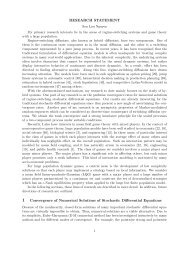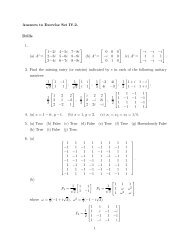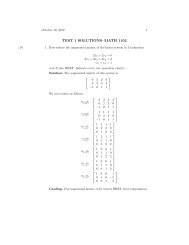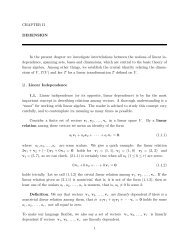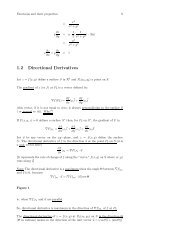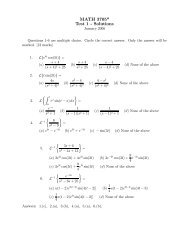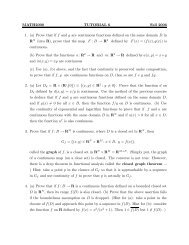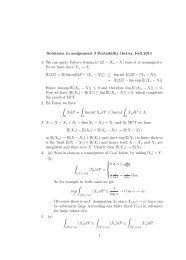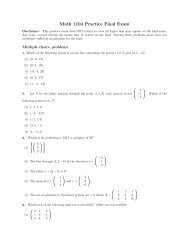CHAPTER 1. 1 — FORMS §1. Differentials: Basic Rules Differentials ...
CHAPTER 1. 1 — FORMS §1. Differentials: Basic Rules Differentials ...
CHAPTER 1. 1 — FORMS §1. Differentials: Basic Rules Differentials ...
Create successful ePaper yourself
Turn your PDF publications into a flip-book with our unique Google optimized e-Paper software.
§<strong>1.</strong> <strong>Differentials</strong>: <strong>Basic</strong> <strong>Rules</strong><br />
<strong>CHAPTER</strong> <strong>1.</strong> 1 <strong>—</strong> <strong>FORMS</strong><br />
<strong>Differentials</strong>, usually regarded as fanciful objects, but barely mentioned in elementary<br />
calculus textbooks, are now receiving our full attention as they deserve. We will see that<br />
these fanciful objects have fantastic powers.<br />
Since they are fanciful objects, it is rather difficult to tell exactly what they are.<br />
However, from our experiences in calculus, spiced by our vivid imagination, we have some<br />
good ideas about how they should behave. Let us start with putting down some “rules of<br />
thumb” governing their behavior:<br />
Rule DF1 (Linearity). d(αu + βv) = αdu + βdv where α, β ∈ R.<br />
Rule DF2 (Leibniz’s Rule or Product Rule). d(uv) = udv + vdu.<br />
Rule DF3 (Chain Rule). du = du<br />
dv if u is a (nice) function of v.<br />
dv<br />
These rules will soon be applied to concrete examples in the routine manner. Before doing<br />
so, we describe an idea leading to such rules swiftly, ignoring mathematical rigor in the<br />
process. (This idea is a bit misleading; however it serves our purpose well at present.)<br />
The expression du here is interpreted as a kind of “polished” change (or increment)<br />
in u, which differs from the real change ∆u by an amount (designated by o(∆u) in the<br />
following identity) so small that practically it may be ignored:<br />
∆u = du + o(∆u).<br />
Here, both ∆u and du are small amounts of u, but their difference o(∆u), comparing to<br />
both ∆u and du, is much smaller. Suppose that we have two quantities u and v, and<br />
due to a slight disturbance or other good reasons, u is changed by an amount ∆u to<br />
u + ∆u and v is changed by ∆v to v + ∆v. Then their product w ≡ uv is changed into<br />
(u + ∆u)(v + ∆v) = uv + u∆v + v∆u + (∆u)(∆v). Thus, the increment in w is given by<br />
∆w = (u + ∆u)(v + ∆v) − uv = u∆v + v∆u + (∆u)(∆v).<br />
Now we “polish” this identity: ∆u and ∆v become du and dv respectively, and ∆w becomes<br />
dw = d(uv). What happens to the product (∆u)(∆v)? Because both ∆u and ∆v are small,<br />
their product is much smaller comparing to each of them and hence can be “polished away”.<br />
1
The final outcome is d(uv) = udv +vdu, namely the Leibniz rule given above. The identity<br />
in Rule DF1 can be obtained in the same fashion, except a lot easier. I leave Rule DF3<br />
for you to derive in this fashion.<br />
You would say, this looks like something familiar in calculus: d(uv) = udv + vdu<br />
d<br />
dv<br />
seems to be nothing new but the usual product rule dxuv = u dx<br />
+ v du<br />
dx<br />
written in a<br />
different way. So what is such a big deal? Well, the usual product rule only applies to<br />
functions of a single variable x. The rates of change du<br />
dx<br />
and dv<br />
dx<br />
of u and v are measured<br />
against the change in x. For differentials, what causes du and dv to emerge is not specified<br />
and immaterial. It may due to the change of one variable, say x, as you learned in the<br />
first year calculus. It may due to the changes of several variables. When I write down the<br />
identity d(uv) = udv + vdu, I do not have to specify what variables are, or even how many<br />
variables are involved. The cause for the “changes” du, dv in u, v may well be a mild<br />
earthquake <strong>—</strong> I don’t care. So the product rule for differentials here has a much wider<br />
appeal. In particular, it applies to the several variable case.<br />
Let us derive some simple consequences of these rules of thumb. From Rule DF2 it<br />
follows immediately that d(u 2 ) = 2udu. By mathematical induction, we can show that<br />
d(u n ) = nu n−1 du<br />
holds for all positive integers n. (This is a good exercise for reinforcing your skill in<br />
induction. Do this.) On the other hand, we have d1 = d(1 2 ) = 2d<strong>1.</strong> Hence d1 = 0. So, if<br />
c is a constant, by Rule DF1, we have dc = cd1 = 0. This is not surprising: we cannot see<br />
any change in a constant c and hence its differential should be zero.<br />
By Rule DF3, we have: d(1/x) = −dx/x 2 , d √ x = −dx/2 √ x, d(1 + x 2 ) = 2xdx,<br />
d sin x = cos x dx, d cos x = − sin x dx, d tan x = sec 2 x dx, d sec x = tan x sec x dx,<br />
de x = e x dx,<br />
d log x = dx<br />
, d arcsin x =<br />
x<br />
dx<br />
dx<br />
√ , d arctan x = , etc.,<br />
1 − x2 1 + x2 (log x here is the same as ln x). Formulae of derivatives you learned in the first year<br />
calculus are very handy.<br />
Example <strong>1.</strong><strong>1.</strong> Find d(e cos t ) and d(log sec x).<br />
Solution: Let u = cos t. From d(e u ) = e u du we have<br />
d(e cos t ) = d(e u ) = e u du = e cos t d(cos t) = e cos t (− sin t dt) = − sin t e cos t dt.<br />
2
cos t<br />
You should feel comfortable with the following way of taking the differential of e<br />
without introducing a new variable u: d(e cos t ) = e cos t d(cos t) = − sin t e cos t dt. Similarly,<br />
<br />
1<br />
d(log sec x) = d log = d(− log cos x)<br />
cos x<br />
= −d(log cos x) = −<br />
d cos x<br />
cos x<br />
= −− sin x dx<br />
cos x<br />
= tan x dx.<br />
(Alternatively, d(log sec x) = (sec x) −1 d sec x = (sec x) −1 sec x tan x dx = tan x dx.)<br />
Example <strong>1.</strong>2. Find dr and d(1/r) for the “radius function” r = x 2 + y 2 + z 2 .<br />
Solution: Applying “d” on both sides of the identity r 2 = x 2 + y 2 + z 2 , we obtain<br />
d(r 2 ) = d(x 2 ) + d(y 2 ) + d(z 2 ), or 2rdr = 2xdx + 2ydy + 2zdz. Thus we arrive at<br />
dr =<br />
xdx + ydy + zdz<br />
r<br />
= xdx + ydy + zdz<br />
x 2 + y 2 + z 2 .<br />
Also, d(1/r) = −dr/r 2 = −(xdx + ydy + zdz)/r 3 = −(xdx + ydy + zdz)/(x 2 + y 2 + z 2 ) 3/2 .<br />
This example illustrates how differentials work for functions of several variables.<br />
<br />
u<br />
<br />
Example <strong>1.</strong>3. Derive the quotient rule d =<br />
v<br />
vdu − udv<br />
v2 .<br />
Solution: Let w ≡ u/v. Then u = vw and hence du = vdw + wdv, which gives a<br />
relation between du, dv and dw. Use this relation to write dw in terms of du and dv:<br />
dw =<br />
which is the desired identity.<br />
du − wdv<br />
v<br />
= du − u<br />
v dv<br />
v<br />
= vdu − udv<br />
v 2<br />
Example <strong>1.</strong>4. It is well-known that the connection between the polar coordinates<br />
(r, θ) and the rectangular coordinates (x, y) is given by<br />
Find dθ in rectangular coordinates.<br />
x = r cos θ, y = r sin θ. (<strong>1.</strong>1)<br />
Solution: We have dx = d(r cos θ) = cos θ dr + r d cos θ = cos θ dr + r(− sin θ) dθ,<br />
and similarly dy = sin θ dr + r cos θ dθ. This gives − sin θ dx + cos θ dy = r dθ. Replacing<br />
sin θ by y/r and cos θ by x/r, we have<br />
dθ = 1<br />
<br />
r<br />
− y<br />
r<br />
x<br />
dx +<br />
r dy<br />
<br />
= −ydx + xdy<br />
r 2<br />
3<br />
= xdy − ydx<br />
,<br />
x2 , (<strong>1.</strong>2)<br />
+ y2
which is the final answer. For an obvious reason, dθ is called an angular form. As we<br />
will see at the end of the present section, putting the angular form as dθ is misleading.<br />
Identity (<strong>1.</strong>2) will be needed in the future for defining winding number of a loop around<br />
the origin.<br />
Example <strong>1.</strong>5. Find the equation of the tangent line to the ellipse<br />
at a point (x0, y0) on this ellipse.<br />
x 2<br />
a<br />
2 + y2<br />
Solution: Applying “d” to both sides of (<strong>1.</strong>3), we obtain<br />
= <strong>1.</strong> (<strong>1.</strong>3)<br />
b2 2x 2y<br />
dx + dy = 0, (<strong>1.</strong>4)<br />
a2 b2 which gives dy/dx = −b 2 x/a 2 y. The slope of the required tangent line is dy/dx at (x0, y0),<br />
that is, −b 2 x0/a 2 y0. So the equation for the tangent line is y − y0 = (−b 2 x0/a 2 y0)(x − x0),<br />
or (x0x − x 2 0)/a 2 + (y0y − y 2 0)/b 2 = 0, which can be rewritten as<br />
due to the fact that (x0, y0) is on the ellipse.<br />
x0x y0y<br />
+ = 1, (<strong>1.</strong>5)<br />
a2 b2 In the rest of the present section we describe how to compute a line integral <br />
γ ω,<br />
where γ is a path and ω is a differential form. Suppose that the variables in ω are<br />
x1, x2, . . . , xn, which can be put together as a vector variable x = (x1, x2, . . . , xn). We<br />
may write ω as ω = n<br />
k=1 Fkdxk where Fk = Fk(x) ≡ Fk(x1, x2, . . . , xn) are functions<br />
in variables xj’s. The path γ can be described in parametric equations as xk = xk(t),<br />
1 ≤ k ≤ n, or, in vector form, x = x(t), where the parameter t is running in some interval,<br />
say I = [a, b]. First consider the special case n = 1 and write ω = F (x)dx. When γ is the<br />
usual path in the real line moving from a to b, that is, x ≡ x(t) = t (a ≤ t ≤ b), the integral<br />
<br />
γ ω clearly should be interpreted as the usual definite integral b<br />
F (t)dt. In the general<br />
a<br />
case, we “pull back” the differential form ω in n variables xj’s via γ to get a differential<br />
form in one variable t, denoted by γ∗ω, and then define <br />
γ ω as b<br />
a γ∗ω. The pullback<br />
γ∗ω of ω here is obtained by the substitutions xj = xj(t) (1 ≤ j ≤ n) into ω. Thus, when<br />
ω = n k=1Fkdxk as before, we have γ∗ω = n k=1 Fk(x(t))dxk(t) = n k=1 Fk(x(t))x ′ k (t)dt.<br />
The line integral <br />
γ ω is, by definition, the integral of γ∗ω over the interval [a, b] :<br />
b<br />
ω = γ ∗ ω, with γ ∗ ω = n<br />
γ<br />
a<br />
k=1<br />
dxk<br />
n<br />
Fk(x(t)) dt, where ω =<br />
dt k=1 Fk(x)dxk.<br />
4
Using this definition, the actual computation of line integrals is quite straightforward.<br />
Example <strong>1.</strong>6. Compute the line integral <br />
γ<br />
xdy + ydz + zdx for three paths linking<br />
the origin (0, 0, 0) to the point (1, 1, 1), the first path being γ = α : x = t, y = t, z = t<br />
(0 ≤ t ≤ 1), the second being γ = β : x = t, y = t 2 , z = t 3 (0 ≤ t ≤ 1), and the third being<br />
γ = η : x = t 2 , y = t 4 , z = t 6 (0 ≤ t ≤ 1).<br />
Solution: Put ω = xdy + ydz + zdx. Do the pull-backs α ∗ ω = tdt + tdt + tdt = 3tdt,<br />
β ∗ ω = td(t 2 ) + t 2 d(t 3 ) + t 3 dt = (2t 2 + 3t 4 + t 3 )dt and η ∗ ω = (4t 5 + 6t 9 + 2t 7 )dt. Hence<br />
we get <br />
1<br />
α ω = 1<br />
0<br />
0 (4t5 + 6t 9 + 2t 7 )dt = 91<br />
60<br />
<br />
3 3tdt = 2 , β ω = 1<br />
0 (2t2 + 3t4 + t3 )dt = 2<br />
3<br />
, the same as <br />
β<br />
+ 3<br />
5<br />
+ 1<br />
4<br />
<br />
91 = 60 , and ω = η<br />
ω. Notice that γ is just a reparametrization of<br />
β. This indicates that the fact that a line integral in general depends on the path but not<br />
on its parametrization.<br />
Example <strong>1.</strong>7. Compute the line integral<br />
<br />
ω ≡<br />
γ<br />
γ<br />
xdy − ydx<br />
x2 ,<br />
+ y2 where γ is the path of going around the unit circle once in the anti-clockwise direction<br />
described by the parametric equations x = cos t and y = sin t with 0 ≤ t ≤ 2π,<br />
Solution: The differential form ω here is just the angular form dθ in Example <strong>1.</strong>4.<br />
So the line integral here is the change of the polar angle θ when a point moves around the<br />
circle once. Thus the answer should be 2π. But let us just follow the definition described<br />
above to compute this line integral. The pull-back γ ∗ ω is<br />
γ ∗ ω =<br />
x(t)dy(t) − y(t)dx(t)<br />
x(t) 2 + y(t) 2<br />
= cos t d sin t − sin t d cos t<br />
cos 2 t + sin 2 t<br />
= dt.<br />
So <br />
γ ω = 2π<br />
dt = 2π. Notice that if γ goes around the unit circle n times instead of<br />
0<br />
once, then the resulting line integral is 2πn<br />
dt = 2πn.<br />
0<br />
A path γ in the xy–plane described by parametric equations x = x(t) and y = y(t)<br />
with a ≤ t ≤ b is called a closed path or a loop if its end points coincide, that is,<br />
<br />
−1 (x(a), x(b)) = (y(a), y(b)). Given a loop γ not passing the origin, the integral (2π) γ ω<br />
(where ω is the angular form) is called the winding number of γ about the origin and is<br />
denoted by W(γ, 0):<br />
W(γ, 0) = 1<br />
<br />
ω ≡<br />
2π γ<br />
1<br />
<br />
2π γ<br />
5<br />
xdy − ydx<br />
x 2 + y 2<br />
.
The above example tells is that the winding number of the loop going around the unit<br />
circles n times is exactly n. In §3.1 we will see that W(γ, 0) is always an integer.<br />
Forming pullbacks is a nice and easy operation. For example, we have<br />
Rule PB<strong>1.</strong> (g ◦ f) ∗ ω = f ∗ (g ∗ ω).<br />
Here, g ◦ f is the composite of g and f: if f sends x = (x1, . . . , xn) to y = (y1, . . . , ym)<br />
and g sends y to z = (z1, . . . , zℓ), then g ◦ f sends x to z: (g ◦ f)(x) = z = g(y) = g(f(x)).<br />
For a differential form ω in the z-space, g ∗ ω is a differential form in y-space with every<br />
occurrence of zj (1 ≤ j ≤ ℓ) in ω replaced by zj = gj(y1, . . . , yn). Similarly, the pull<br />
back f ∗ (g ∗ ω) of g ∗ ω is a differential form in x-space obtained by another substitution.<br />
Certainly the result of consecutive substitutions by g followed by f is the same as the<br />
single substitution by their composite g ◦ f. So Rule PB1 is clear. From this rule we can<br />
deduce the identity <br />
Indeed, <br />
g◦γ<br />
<br />
ω =<br />
γ<br />
g ∗ ω.<br />
g◦γ ω = b<br />
a (g ◦ γ)∗ ω = b<br />
a γ∗ (g ∗ ω) = <br />
γ g∗ ω.<br />
A differential form ω is said to be exact if it is the differential of some function f,<br />
that is ω = df. In that case, the pull back of ω = df = n k=1 (∂f/∂xk)dxk is given by<br />
γ ∗ ω = n<br />
k=1<br />
<br />
∂f <br />
<br />
∂xk<br />
dxk(t) = d(f(x(t))) ≡<br />
x(t)<br />
d<br />
f(x(t)) dt<br />
dt<br />
(<strong>1.</strong>7)<br />
(the subscript x(t) indicates the point at which ∂f/∂xk is evaluated) and hence we have<br />
<br />
γ ω = b<br />
a γ∗ω = b d<br />
a dtf(x(t)) dt = f(x(b)) − f(x(a)). We conclude:<br />
<br />
γ<br />
df = f(the terminal point of γ) − f(the initial point of γ). (<strong>1.</strong>8)<br />
In particular, if γ is a loop, that is, x(b) = x(a), then <br />
<br />
ω = 0. Thus the line integral γ γ ω<br />
depends only on the end points but not on the path γ linking them. This may be called<br />
the path-independence property of line integrals for exact forms. The differential form<br />
xdy + ydz + zdx in Example <strong>1.</strong>6 does not have this property, because its integrals along<br />
two paths α and β with same end points are different. Notice that (<strong>1.</strong>7) actually shows<br />
that γ ∗ df = dγ ∗ f, where γ ∗ f, as a function of t is f(x(t)). This is not surprising because<br />
forming pull backs (or substitution) and taking differentials are independent actions like<br />
“kicking and punching”. In general, we have<br />
6
Rule PB2. g ∗ df = d(g ∗ f) ≡ d(f ◦ g).<br />
Now we explain why putting the angular form as dθ is problematic. In rectangular<br />
coordinates, the angular form is ω = (−ydx + xdy)/(x 2 + y 2 ), which is defined everywhere<br />
except the origin. The expression dθ wrongfully suggests the exactness of ω. If ω were<br />
exact, then <br />
ω would be zero for any closed path γ. But, as shown in Example <strong>1.</strong>7, when<br />
γ<br />
γ goes around the unit circle once in anticlockwise direction, the line integral <br />
ω turns<br />
out to be 2π, not 0. The trouble here is caused by the fact that, although ω is defined on<br />
the punctured plane R 2 \{(0, 0)} (the Euclidean plane with the origin removed), θ cannot<br />
be properly defined on the punctured plane. We may let the domain D for θ be the plane<br />
with the negative part of the x-axis removed: D = {(x, y) : y = 0 or x > 0}. Then θ<br />
becomes a genuine function defined on D satisfying −π < θ < π, called the principal value<br />
of “arg”.<br />
Exercises<br />
<strong>1.</strong> Calculate the following differentials: (a) d(e −x2 /2 y<br />
), (b) d(log log x), (c) d sin x ,<br />
(d) d (xy ), (e) d(log r), where r = x2 + y2 + z2 .<br />
2. Find the tangent plane to the sphere x 2 + y 2 + z 2 = 3 2 at the point P0 = (2, −2, −1)<br />
by using the method described in the remark after Example <strong>1.</strong>5.<br />
3. Derive the product rule d(uv) = udv + vdu from d(u 2 ) = 2udu. (Hint: compute<br />
d (u + v) 2 in two different ways.)<br />
4. Derive the product rule for three functions: d(uvw) = uvdw + uwdv + vwdu. Write<br />
an expression for d(u1u2 · · · un), giving the product rule for n functions.<br />
5. The logarithmic differential of u, denoted by ℓu here (this is not a standard notation),<br />
is defined to be du/u. Verify each of the following identities: (a) ℓ(uv) = ℓu + ℓv,<br />
(b) ℓ(u/v) = ℓu − ℓv, (c) ℓ(u v ) = v((log u)ℓv + ℓu), (d) ℓ(e v ) = v ℓv and (e) ℓ log v =<br />
ℓv/ log v. Part (a) can be generalized as ℓ(u1u2 · · · un) = ℓu1 + ℓu2 + · · · + ℓun. Does<br />
it help you to write down the product rule for n functions, which is asked in the last<br />
exercise?<br />
6. A point P = (x, t) in the xt-plane is said to be inside the future cone C + if t > 0<br />
and t 2 − x 2 > 0. The hyperbolic distance of such a point to the origin is given by<br />
r = √ t 2 − x 2 . The hyperbolic coordinates (r, θ) of P is related to (x, t) by x = r sinh θ,<br />
7<br />
γ
t = r cosh θ, where sinh θ = (e θ − e −θ )/2, cosh θ = (e θ + e −θ )/2 are the hyperbolic<br />
sine and cosine functions. Find dr and dθ in terms of dx and dt.<br />
7. Compute the differentials drx, dry, dθx and dθy, where<br />
rx = x<br />
r , ry = y<br />
r , θx = − y<br />
r2 , θy = x<br />
,<br />
r2 <br />
r = x2 + y2 <br />
.<br />
(This exercise will be useful for computing the Laplacian in polar coordinates.)<br />
8. Consider the spherical coordinates (r, θ, φ) of a point P , where r is the distance to the<br />
origin, θ is the longitude and φ is the latitude of P . Its relation to the rectangular<br />
coordinates is given by x = r cos θ cos φ, y = r sin θ cos φ and z = r sin φ. (The conven-<br />
tion of spherical coordinates here differs from some books.) Express the differentials<br />
dr, dθ and dφ in rectangular coordinates. (Hint: The computation is rather tedious.<br />
However, Example <strong>1.</strong>2 helps.)<br />
9. Compute the line integral <br />
γ xdy − ydx, where γ is the path given by x = cos2 t,<br />
y = sin 2 t (0 ≤ t ≤ π/2). Note that γ moves from (1, 0) to (0, 1) along the line<br />
x + y = <strong>1.</strong> What happens when you change the parametrization of this path to<br />
x = 1 − t, y = t, or to x = 1 − t 2 , y = t 2 ?<br />
10. For a loop γ, why is <br />
<br />
xdy + ydx always zero, while xdy − ydx in general is not?<br />
γ γ<br />
For a loop γ, we have <br />
1 xdy = γ 2 (xdy − ydx). Why?<br />
γ<br />
1<strong>1.</strong> We have seen that if a differential form ω is exact, then any line integral <br />
ω depends<br />
only on the end points of γ. Prove that the converse of this statement is also true by<br />
following the steps described below. Assume that ω = F1dx1 + F2dx2 + · · · + Fndxn<br />
is a differential form having the property that any line integral <br />
ω depends only<br />
on the end points of γ. Fix any point p in the domain of ω. For any point x, let<br />
f(x) = <br />
ω, where γ is any path from p to x. This definition of f(x) makes sense<br />
γ<br />
because of the assumption on ω here. Complete the proof by checking ∂f/∂xk = Fk,<br />
which uses<br />
∂f<br />
∂xk<br />
<br />
<br />
<br />
<br />
x<br />
= lim<br />
h→0<br />
f(x + hej) − f(x)<br />
h<br />
where ej is the jth vector of the natural basis of R n , namely ej = (δj1, δj2 . . . , δjn),<br />
where δjk is Kronecker’s delta: it is 0 if j = k and is 1 if j = k.<br />
8<br />
γ<br />
γ


